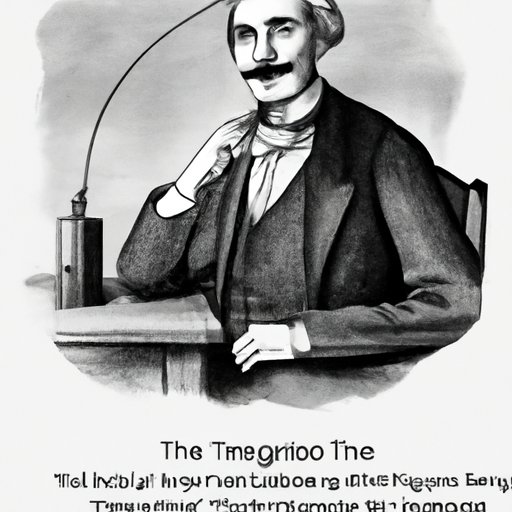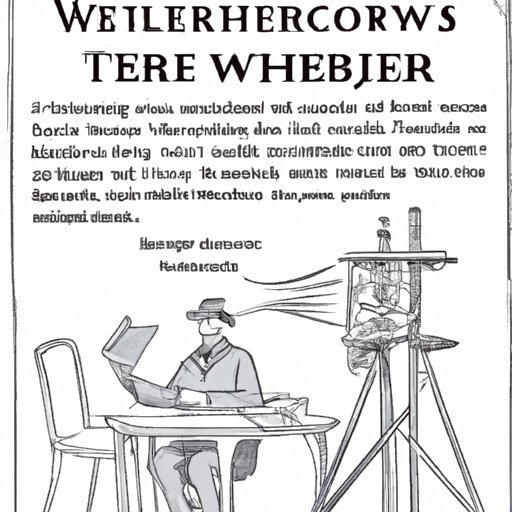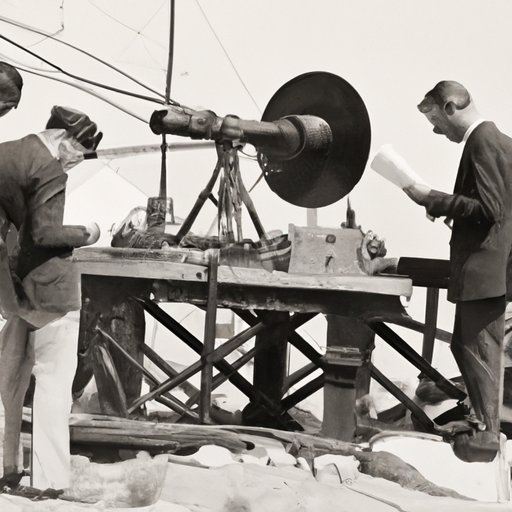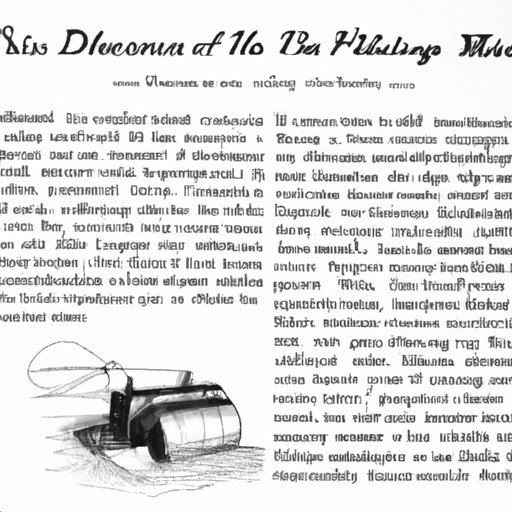Introduction
Wireless telegraphy is the transmission of information over a distance without the use of physical connections or wires. It is an important technology that has been used in many different aspects of communication, from radio broadcasting to cell phone networks. The invention of this technology has changed the way we communicate and has had a major impact on the development of modern society.
The need to know who invented wireless telegraphy is essential to understanding the history of this technology and its impact on our lives. In this article, we will explore the history of wireless telegraphy and take a closer look at the three pioneers behind this historic invention: Guglielmo Marconi, Nikola Tesla, and David Edward Hughes.

A Historical Look at Who Invented Wireless Telegraphy
Guglielmo Marconi was an Italian inventor who is widely credited with inventing the first practical wireless telegraphy system. Born in 1874, Marconi started experimenting with wireless signals at the age of 20. He eventually developed a system that could transmit signals up to two miles away. His invention revolutionized the way people communicated and paved the way for the development of radio.
Nikola Tesla was a Serbian-American inventor who is also credited with pioneering wireless telegraphy. Born in 1856, Tesla was a prolific inventor who created a number of innovative technologies. He developed a system that could transmit messages wirelessly across long distances, which he demonstrated in 1893. His invention helped usher in the age of radio.
David Edward Hughes was another pioneer in the field of wireless telegraphy. Born in 1831, Hughes was a British physicist and inventor who developed a system for transmitting signals wirelessly. He demonstrated his invention in 1879, which predated both Marconi and Tesla’s inventions. Although he did not receive much recognition for his work, Hughes is now considered one of the fathers of wireless telegraphy.
Exploring the Pioneers Behind Wireless Telegraphy
Marconi’s contributions to the invention of wireless telegraphy cannot be underestimated. He was the first to develop a practical system for sending signals wirelessly and demonstrated it in 1895. His invention allowed for the transmission of signals up to two miles away, which was a significant increase from the range of previous systems. He also went on to develop a system capable of transmitting signals across the Atlantic Ocean, which he did in 1901.
Tesla was another important figure in the development of wireless telegraphy. He developed a system for sending messages wirelessly over long distances, which he demonstrated in 1893. He also patented the Tesla coil, an important component of wireless telegraphy systems. His inventions helped pave the way for the development of radio.
Hughes was a lesser-known figure in the invention of wireless telegraphy, but his contributions should not be overlooked. He developed a system for sending signals wirelessly in 1879, which predated both Marconi and Tesla’s inventions. He also patented a number of components related to wireless telegraphy, including the microphone and the carbon transmitter.
Understanding the Innovations of Wireless Telegraphy
Marconi’s system was the first practical wireless telegraphy system. It allowed for the transmission of signals up to two miles away and was the first system to demonstrate that wireless signals could travel long distances. Marconi also developed a system capable of transmitting signals across the Atlantic Ocean, which was a major breakthrough in the development of wireless telegraphy.
Tesla’s system was the first to demonstrate that wireless signals could be sent over long distances. He also developed the Tesla coil, which is an important component of wireless telegraphy systems. His inventions helped pave the way for the development of radio.
Hughes’ system was the first to demonstrate that wireless signals could be sent without using wires. He also patented a number of components related to wireless telegraphy, including the microphone and the carbon transmitter. His inventions helped make wireless telegraphy more efficient and reliable.
Unpacking the Invention of Wireless Telegraphy
Marconi was the first to patent his system for sending signals wirelessly. His patent, granted in 1896, covered the use of radio waves for telegraphy. He also held several other patents related to wireless telegraphy, including a patent for a spark gap transmitter.
Tesla was the first to patent his system for sending signals wirelessly. His patent, granted in 1897, covered the use of radio waves for telegraphy. He also held several other patents related to wireless telegraphy, including a patent for the Tesla coil.
Hughes was the first to patent his system for sending signals wirelessly. His patent, granted in 1880, covered the use of electromagnetic waves for telegraphy. He also held several other patents related to wireless telegraphy, including a patent for a microphone.

A Comprehensive Guide to Wireless Telegraphy Inventors
Marconi’s legacy in the field of wireless telegraphy is undeniable. His invention revolutionized the way people communicated and paved the way for the development of radio. He held several patents related to wireless telegraphy, and his inventions helped make wireless telegraphy more efficient and reliable. Marconi was awarded the Nobel Prize in physics in 1909 for his work in the invention of wireless telegraphy.
Tesla’s legacy in the field of wireless telegraphy is also impressive. He developed a system for sending messages wirelessly over long distances and patented the Tesla coil, an important component of wireless telegraphy systems. His inventions helped usher in the age of radio. He was also awarded the Edison Medal in 1917 for his contributions to the invention of wireless telegraphy.
Hughes’ legacy in the field of wireless telegraphy is often overlooked, but his contributions should not be underestimated. He developed a system for sending signals wirelessly in 1879, which predated both Marconi and Tesla’s inventions. He also patented a number of components related to wireless telegraphy, including the microphone and the carbon transmitter. Although he did not receive much recognition for his work, Hughes is now considered one of the fathers of wireless telegraphy.

Examining the Contributions of Wireless Telegraphy Inventors
Marconi’s invention of wireless telegraphy had a major impact on the development of modern society. His invention revolutionized the way people communicated and paved the way for the development of radio. His inventions also made wireless telegraphy more efficient and reliable, which allowed for the transmission of signals across long distances.
Tesla’s invention of wireless telegraphy also had a major impact on the development of modern society. His invention helped usher in the age of radio and made wireless telegraphy more efficient and reliable. He also developed the Tesla coil, which is an important component of wireless telegraphy systems.
Hughes’ contribution to the invention of wireless telegraphy is often overlooked, but his work should not be underestimated. He developed a system for sending signals wirelessly in 1879, which predated both Marconi and Tesla’s inventions. He also patented a number of components related to wireless telegraphy, including the microphone and the carbon transmitter.
Conclusion
In conclusion, Guglielmo Marconi, Nikola Tesla, and David Edward Hughes are all considered pioneers in the invention of wireless telegraphy. Their contributions helped revolutionize the way people communicated and ushered in the age of radio. Their inventions made wireless telegraphy more efficient and reliable, which allowed for the transmission of signals across long distances. Their legacies in the field of wireless telegraphy are undeniable and have had a major impact on the development of modern society.
The invention of wireless telegraphy has changed the way we communicate and has had a major impact on the development of modern society. The three pioneers behind this historic invention—Guglielmo Marconi, Nikola Tesla, and David Edward Hughes—all played a crucial role in the development of this technology and helped shape the world we live in today.
(Note: Is this article not meeting your expectations? Do you have knowledge or insights to share? Unlock new opportunities and expand your reach by joining our authors team. Click Registration to join us and share your expertise with our readers.)
